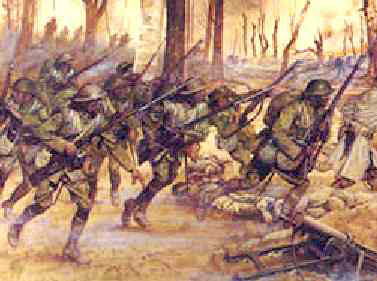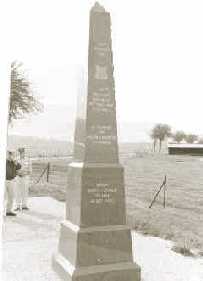The Story of the American Expeditionary Forces |

|
DETACHED SERVICEBYSEGREGATED INFANTRY UNITS |
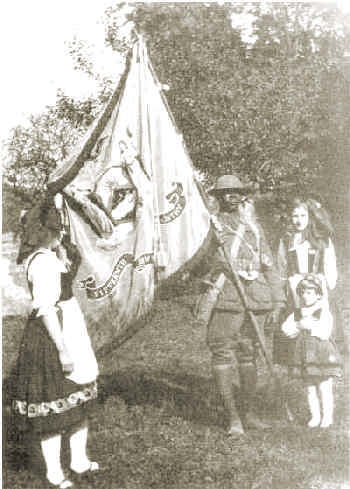
Colors of NY 15th Colored Infantry
[369th Infantry, AEF; Known as the "Harlem Hellfighters"]

|
Each of the four segregated infantry regiments of the 93rd Division [369th,370th,371st & 372nd] were parceled out to French Divisions. The soldiers were issued French rations and equipment, most memorably, the distinctive French helmet. They never fought together as a division, although, three of them served very close-by in the Champagne. The other regiment, the 370th Infantry, served north of the Marne. 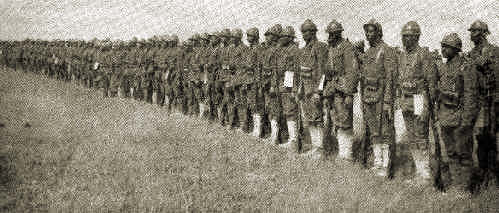 Black Doughboys in their French KitsHow over 15,000 American soldiers came to be nearly amputated from their own army is difficult to fathom today. It was partly a vestige of the segregated character of American society in those days, and partly due to the desperate need of the French Army for fresh assault troops combined with their positive experience with their Colonial forces. A. The 369th, 371st and 372nd Infantry Regiments in the ChampagneWhen the French Fourth Army advanced northward in the Champagne on September 26th three regiments of the 93rd American Division were included as units in the French divisions of the IX Corps, which was directed to attack from a position a few miles west of the Argonne Forest. The 369th Infantry had entered this general area on April 16, 1918, and was in support when the attack of September 26th started, attached to the 161st French Division. It had held a section of trenches near Butte du Mensil from July 23rd to August 19th. The division eventually advance north to the Souain - Cernay road. The 369th entered a gap in the line during the first day and took the town of Ripont, capturing a number of prisoners and several pieces of artillery. It continued forward during the 27th and 28th, gaining a foothold on Bellevue Signal Ridge. 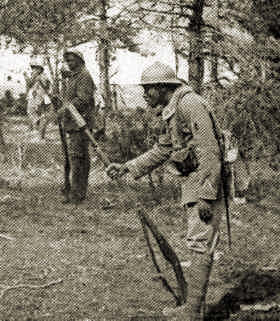 Advancing in WoodsOn the 28th the 371st and the 372nd Infantry entered the lines as part of the 157th French Division and attacked at once, advancing about one kilometer. The 372nd made an unsuccessful attack against Sechault from the west on the 29th, its units became intermingled and it was withdrawn for reorganization. On the 29th the 369th Infantry captured Sechault, while the 371st took Ardeuil and Montfauxelles. On the 30th, the 369th again made a small advance and was relieved from the line that evening, after having suffered heavy casualties. On the same date the 371st captured Trieres Farm.
. B. The 370th Infantry Regiment in the Marne SectorThe 370th Infantry, which had served during the summer in both the St. Mihiel and Argonne regions with French units, joined the 59th French Division near Tartiers on September 15th. Four of its companies assisted French troops in unsuccessful attacks against Mont des Singes between September 15th and 22nd, and on the 24th the regiment entered the front line as a unit, just north of Vauxaillon. The 59th Division attacked September 28th, and the 370th Infantry, as one of the assault units, succeeded by October 4th in advancing its lines to the south bank of the Ailette River. 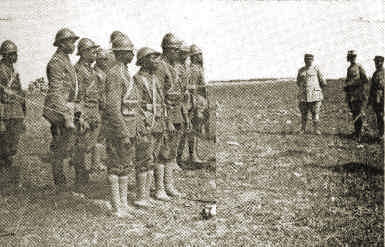 American Troops Inspected by French OfficersThe Germans began a withdrawal from this front on October 12, and the American regiment force a crossing of the Ailette River, advancing into the Bois de Morier. Thereafter, acting as division reserve, it participated in the pursuit as far as Bucy-les-Cerny. The division was then relieved, only to reenter the battle at Grandlup late in October, the American regiment being placed in support near Chantrud Farm, northeast of Laon. There it suffered a loss of 80 men from a single shell on November 3rd. The Germans made a general retirement in early November, and the 59th Division took part in the pursuit. Although spasmodic fighting occurred, the 370th advanced mainly in march formation. At the time of the armistice the forward battalion of the regiment was at Le Gue d'Hossus, having advanced about 40 miles during the last week of the war. |
|
Sources and thanks: Source: Taken with only minor revisions from AMERICAN ARMIES AND BATTLEFIELDS IN EUROPE. The Hellfighters Painting is on the website of the Army Historical Center. Eric Mansuy who lives near Epinal in the heart of the Vosges provided the photo of the 15th NY. Regular contributor Glenn Hyatt provided the remainder of the photos. MH |
To find other Doughboy Features visit our |
Membership Information  Click on Icon |
For further information on the events of 1914-1918
visit the homepage of |
Michael E. Hanlon (medwardh@hotmail.com) regarding content,
or toMike Iavarone (mikei01@execpc.com) regarding form and function.
Original artwork & copy; © 1998-2000, The Great War Society
